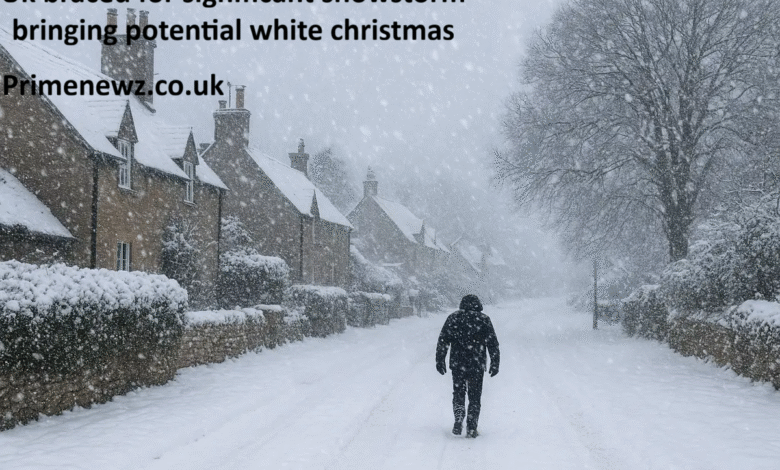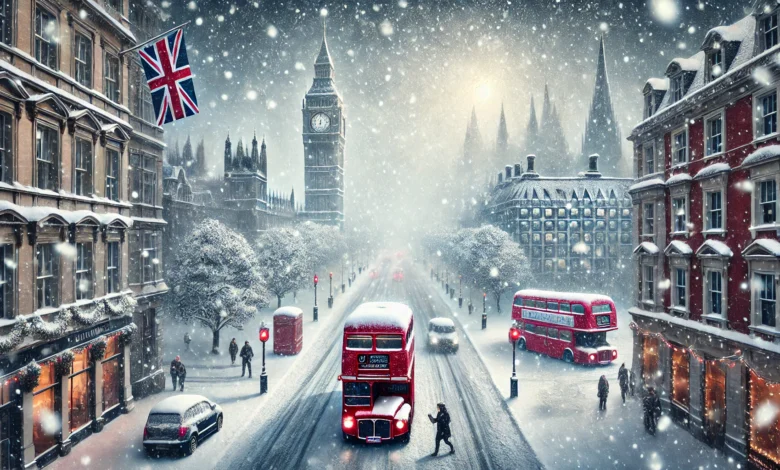UK Braced for Significant Snowstorm Bringing Potential White Christmas: What to Expect This Winter

As the UK settles into UK Braced for Significant Snowstorm Bringing Potential White Christmas the winter months, weather forecasters have been monitoring conditions that could bring significant snowfall across various parts of the country. While the nation didn’t experience a traditional white Christmas in 2024, meteorologists have identified patterns suggesting that substantial winter weather could still impact Britain throughout the remainder of the season, with January and February typically bringing the highest probability of snow accumulation.
Understanding the Winter Weather Patterns
Winter 2024/25 brought a typical mix of UK winter weather conditions, including both wet and windy periods alongside cold and calm spells. The season has been characterized by above-average temperatures overall, yet this UK Braced for Significant Snowstorm Bringing Potential White Christmas masks the reality of several high-impact weather events. Over 100 Met Office warnings were issued during the meteorological winter months of December, January, and February, including 9 Amber Warnings and 3 Red Warnings.
The winter pattern has been influenced by shifts in the jet stream, which determine whether the UK experiences mild, wet conditions UK Braced for Significant Snowstorm Bringing Potential White Christmas from Atlantic systems or colder air masses from the north and east. These shifts can result in an increase in the frequency of Atlantic low pressure systems bringing wind and rain to the UK, with some developing into named storms.
The Reality of White Christmas Dreams
For those hoping for a picture-perfect white Christmas, the reality proved disappointing in 2024. Christmas Day 2024 was likely to be settled, cloudy and dry with light winds for most of the UK, with temperatures expected to be widely mild. The Met Office’s definition of a white Christmas requires only a single snowflake to fall UK Braced for Significant Snowstorm Bringing Potential White Christmas somewhere in the UK during the 24 hours of December 25th, making it technically achievable even without the romantic blanket of snow many envision.
The last widespread white Christmas in the UK occurred in 2010, when snow lay on the ground at 83% of stations, the highest amount ever recorded. Such widespread coverage is extremely unusual in modern times. Snow has fallen UK Braced for Significant Snowstorm Bringing Potential White Christmas somewhere in the UK on Christmas Day 54 times in the last 65 years, though settling snow is far less common.
January and February: The True Snow Months

While December often captures our UK Braced for Significant Snowstorm Bringing Potential White Christmas attention due to the Christmas period, meteorologists consistently point out that the UK’s snowiest months actually come later in winter. The UK is more likely to see snow in January and February than in December, with snow actually settling on the ground an average of 3 days in December, compared to 3.3 days in January, 3.4 days in February and 1.9 days in March.
During the New Year transition period from late December 2024 into January 2025, a combination of rain, strong winds and snow featured in the UK forecast, with Yellow National Severe Weather Warnings in place across various parts of the UK Braced for Significant Snowstorm Bringing Potential White Christmas Scotland from Perthshire northwards and eastwards experienced precipitation falling as snow, leading to 10-20cm accumulations over higher ground, with strong winds creating blizzard-like conditions for a time.
Regional Variations in Snowfall
Snow distribution across the UK varies dramatically by geography and elevation. When cold air arrives from the Arctic across northern Scotland, showers turn increasingly wintry with hail, sleet and some snow, with 5 to 10 cm possible on high ground above 300 metres. Scotland, particularly the Highlands and areas at elevation, consistently sees UK Braced for Significant Snowstorm Bringing Potential White Christmas the most significant snow accumulation during winter months.
Northern England and Wales also experience considerable wintry conditions during cold spells. On New Year’s Day, snow affected parts of Northern Ireland, southern Scotland and northern England, with locally 10-15cm of snowfall possible, and larger amounts over higher hills. The combination of snow and strong winds can create drifting conditions, making travel particularly hazardous in these regions.
Major Storm Events This Winter
The 2024/25 winter season has already witnessed two particularly severe storms that warranted red warnings from the Met Office. Storm Darragh in December 2024 brought a peak gust of 96mph and significantly strong winds for parts of Wales and the southwest of England. The awareness campaign surrounding these warnings UK Braced for Significant Snowstorm Bringing Potential White Christmas proved highly effective, with the vast majority of those in affected areas taking action to protect themselves and their property.
Storm Éowyn in late January 2025 was the UK’s most powerful windstorm in over a decade, bringing red warnings, severe impacts and, tragically, fatalities, with Northern Ireland and Scotland’s Central Belt experiencing winds gusting widely at well over 80mph. The highest wind gust recorded was 100mph at Drumalbin in Lanarkshire, and a UK Braced for Significant Snowstorm Bringing Potential White Christmas weather station on Tiree recorded the UK’s lowest pressure reading since storm naming was introduced in autumn 2015.
Preparing for Winter Weather Hazards
Understanding winter weather risks helps households and businesses prepare appropriately. A total of 108 severe weather warnings were issued during meteorological winter 2024/25, with the majority falling into the yellow category. These warnings provide crucial advance notice of potentially hazardous conditions, allowing people to adjust travel plans and secure property.
Flooding remains one of the main impacts of extreme winter weather in the UK. The Met Office works in collaboration with the Environment Agency, Scottish Environment Protection Agency, Natural Resources Wales and Northern Ireland UK Braced for Significant Snowstorm Bringing Potential White Christmas Direct to capture regional risks. Local sensitivities of rivers and catchment areas to rainfall, combined with tide times, significantly influence flooding likelihood.
Climate Context and Long-Term Trends
Climate change has brought higher average temperatures over land and sea, generally reducing the chances of a white Christmas. Despite this warming trend, the UK still experiences significant winter weather events, though their character may be changing. Winter 2024/25 saw above average temperatures for the UK with a UK Braced for Significant Snowstorm Bringing Potential White Christmas mean temperature of 4.6°C, just over half a degree above the long-term meteorological average.
The season’s precipitation patterns showed interesting variation. After a wetter than average December and a drier than average January and February, winter concluded with 11% less rainfall than its long-term meteorological average. However, this overall figure masks considerable regional differences and the impact of concentrated rainfall during storm events.
What Residents Should Know
For UK residents navigating winter weather, several key facts emerge from meteorological data. Forecasting snow remains notoriously challenging, with temperature variations of just a fraction of a degree determining whether precipitation falls as rain or snow. The Met Office can accurately forecast Christmas Day snow only up to fUK Braced for Significant Snowstorm Bringing Potential White Christmas ive days in advance, making early predictions unreliable.
Higher elevations consistently receive more snow than lowland areas, with accumulations on hills and mountains often reaching 10-20cm during cold spells while valleys see little to no settling snow. Northern and western areas face greater exposure to Atlantic weather systems, experiencing more frequent rain and wind, while eastern areas UK Braced for Significant Snowstorm Bringing Potential White Christmas can see colder conditions when continental air masses arrive from Europe.
Winter preparation extends beyond monitoring forecasts. Checking weather warnings regularly during winter months, particularly before travel, proves essential for safety. Understanding that January and February pose higher snow risks than December helps set realistic expectations and allows for appropriate planning.
Looking Ahead
As Britain progresses through the winter season, meteorologists continue monitoring atmospheric patterns that determine weather outcomes. While the romantic vision of a widespread white Christmas remains elusive for most, the UK can still expect significant winter weather through February. The combination of monitoring technology, warning systems, and public awareness means communities can prepare effectively for whatever conditions arise, from powerful Atlantic storms to Arctic cold snaps bringing snow to higher ground and northern regions.



